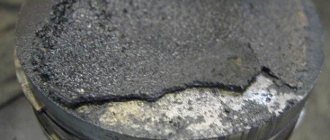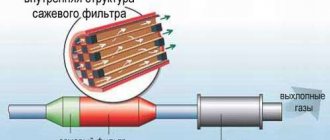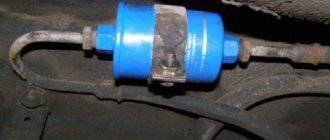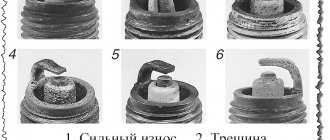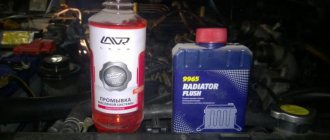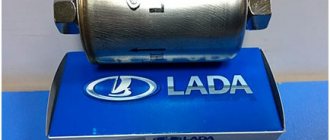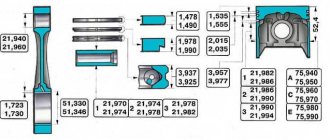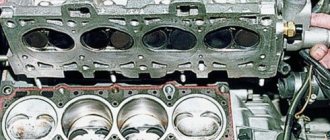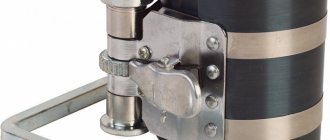Principle of operation
In order to perform a procedure such as cleaning a part, you need to understand how it works. In the internal combustion chamber, the gases expand and energy is transferred to the piston. The connecting rods then drive the crankshaft. This block is continuously exposed to temperature, mechanical and other extraneous loads. Experiencing the force of gas pressure, the piston becomes very hot due to contact with substances that are formed from the combustion of fuel.
Due to the increased load on the piston during operation, black carbon deposits gradually form on it. This also happens due to some kind of motor failure. Often such malfunctions can become a factor affecting the disruption of the combustion process of the fuel mixture inside the cylinders.
We remove carbon deposits from the engine without disassembling it
Over time, deposits begin to accumulate in the car engine, preventing it from working properly. Dealing with carbon deposits is not difficult, this is required.
No matter how often car enthusiasts change the engine oil and no matter how high-quality fuel they select, carbon deposits still appear over time in one way or another. Moreover, it forms almost everywhere: on pistons, valves. Its presence on the rings significantly reduces their mobility.
The reasons for the large amount of soot are primarily due to low-quality fuel, which does not burn completely. They may also consist of incorrectly selected oil or low quality oil.
It is very harmful to immediately load a cold internal combustion engine. It is important to warm it up.
How can you tell if your internal combustion engine is heavily polluted?
In this case, the car begins to constantly overheat for no apparent reason. That is, there is no leak, the antifreeze is normal, but the car overheats, the cooling fan works all the time. The reason for this is the deterioration of heat transfer.
When starting the internal combustion engine after a long stop (about 5 - 6 hours in summer and more than 3 hours in winter), black smoke comes out of the exhaust pipe for about half a minute or less. The internal combustion engine does not operate quite smoothly after it is started. After warming up, engine performance immediately improves. The interior may feel burnt. The “traction” becomes worse - the car takes longer to gain speed. Fuel is consumed more than usual by about 1/5. When the ignition is turned off, detonation may occur. As a result, a noticeable vibration is felt. This is due to the combustion of the remaining fuel. It ignites from heated carbon deposits.
Is it possible to remove carbon deposits without disassembling the engine?
So, you need to buy compressed air (it is sold in cans), a syringe with a tube and a liquid intended for decarbonization. The pistons will need to be set to the same level. Use the key to turn the crankshaft pulley, or lift the front wheel, then engage fifth gear, then start turning the wheel. A tube and syringe are useful for pouring liquid. Decarbonization will take time, about 2 hours, but more is better. Then the liquid should be removed from the wells. After this, you need to blow out the spark plug wells with compressed air. Then you should get into the car, turn on the ignition, press the gas and turn the starter for 5 seconds. After this, put the spark plugs back and start the car engine. It should work for about ten minutes. Initially, black smoke will be observed, which means that the product remaining in the engine is burning through.
To clean the rest of the internal combustion engine, flushing oil is required. It requires driving approximately 100 kilometers. When traveling, there is no need to put any load on the engine. Then the oil should be washed off, fill with regular oil and drive the car quietly, the washing is completed.
Liked? Give it a class! Subscribe to the channel if you like cars
!
Source
What is carbon deposits on pistons?
Looking inside the power plant, we will definitely see that many parts are covered with deposits of various types. Experienced drivers divide them into sludge, carbon deposits and varnish formations. One of the reasons for the formation of deposits is the breakdown of engine oil in the engine. It oxidizes and decomposes over time, so breakdown products can settle on the elements, forming a deposit. Therefore, every driver should know how to clean the piston from carbon deposits.
Causes of soot
The most common cause of soot is incomplete combustion of fuel or a high percentage of various impurities and additives in the fuel. Once fuel comes into contact with a heated piston, valves or cylinder walls, harmful additives begin to accumulate, and over time a whole layer of deposits forms.
One common reason is infrequent oil changes. When the driver does not take care of regular inspection of this system, the engine gradually begins to coke. Therefore, experienced car mechanics recommend changing the oil after driving 15-20 thousand km. Other factors that affect piston fouling include:
Sludge most often forms on the side surfaces of pistons and cylinder walls. Experts believe that carbon deposits appearing at the top of the piston will contribute to increased wear on the cylinder walls. Deposits can become lodged in the gap between the groove and the ring on the piston. This leads to significant engine wear. Therefore, it is better to fix the problem as quickly as possible.
Reasons for the formation of deposits and soot in the engine
The use of high-quality oils does not eliminate the problem of coking, since deposits and carbon deposits can form in the engine for reasons not related to the quality of fuels and lubricants:
- Engine overheating . As a result of regular overheating, the oil ages faster, loses viscosity and forms polymer deposits in the grooves under the piston rings, on the walls of the combustion chamber, lubrication system and other parts.
- Operation in low temperature conditions . The water vapor generated during the combustion of fuel reacts with cold oil, which leads to the formation of sludge in the crankcase.
- Urban operating mode . Short trips and stuck in traffic jams. With such operation, the engine does not return to normal operating mode, and, as a result, carbonization of the cylinder-piston group begins.
- Untimely oil changes lead to a sharp increase in deposits resulting from oil aging processes.
- Worn turbocharger , as a result of which hot exhaust gases begin to enter the oil and the properties of the oil change.
- Antifreeze enters the crankcase during depressurization of the cooling system, which changes the properties of the oil and initiates its polymerization processes.
- Poor quality fuel . When fuel is incompletely burned, some of it enters the engine crankcase through the rings and accelerates the aging process of the oil.
- The formation of excess soot due to weak compression or late fuel injection in diesel engines.
Cleaning pistons without disassembling the engine
According to experienced specialists with many years of practice, it is imperative to use manual mechanical cleaning in order to efficiently and quickly remove carbon deposits from pistons and other internal combustion engine parts. It turns out that first you need to almost completely disassemble the power plant. This method is the most labor-intensive and costly, so many car owners try to make do with cleaning the pistons from carbon deposits without disassembling them.
In this case, decoking of the engine and piston rings is done. In this method of cleaning pistons from carbon deposits, the parts are not removed from the machine. Products intended for this purpose are active solvents. They are poured into the engine through spark plug holes or through the lubrication system. Thanks to this, the pistons are cleaned without additional time and financial costs for disassembly.
A similar product can be purchased at any store that sells auto chemicals. These products are produced by well-known brands - Liqui Moly, Xado, Gzox. For decarbonization, it is best to use products from these companies. Automotive chemicals have their own advantages and disadvantages. The advantages include the speed of the procedure and a gentle effect on the engine. The disadvantages of this method are that during these manipulations it will not be possible to remove carbon deposits from the combustion chamber of the valves and the piston surface. In addition, according to many motorists, Gzox for decarbonization can only wash oil scraper piston rings.
Therefore, this decision is classified as preventive. If the engine is very dirty, then these procedures will not help get rid of problems such as carbon deposits.
Chemicals and equipment used using BG technology
- Decoking of piston rings and cleaning of all elements of the oil supply system (soft method). To do this, special cleaning agents are added to the oil system, for example BG 109. The purpose of such cleaning is to decarbonize the oil scraper rings and free the lower compression rings from carbon deposits.
- Supply of cleaning agent through the fuel system. The purpose of this method is to clean the injectors, intake valves, decarbonize the upper compression rings and remove carbon deposits from the walls of the combustion chamber and exhaust valves.
- Decarbonization using the BG 9408 Squid apparatus (hard method). The cleaning liquid is supplied from this device through special adapters installed in place of the spark plugs or injectors directly into the combustion chambers. The BG 9408 device comes complete with an engine starter control unit, which “cranks” the engine at specified intervals, forcing the pistons and rings to “move,” which improves the decarbonization process. This method allows you to perform a complete and high-quality decarbonization of the engine using a rigorous cleaning method.
- Method of delivering cleaning solvent through an air supply system as part of an induction service for diesel or gasoline engines. The purpose of this service is to flush the intake system (throttle valve, mass air flow sensor, decoking of the intake valves on the intake side), and including complete cleaning of the engine from carbon deposits without disassembly, with decoking of the rings.
Removing deposits from the combustion chamber and piston
This method is designed for the solvent cleaner to be poured directly into the combustion chamber. Thanks to this, the soot loosens. And after the engine resumes operation, all deposits simply burn off. It should be borne in mind that this type of decarbonization will require more aggressive means. The most effective of them is considered to be the Lavr cleaner or its analogues.
In order to quickly decarbonize without removing the power unit and not spend too much time, you must follow the sequence of work:
- Warm up the engine to operating temperature, without allowing it to cool, and remove the spark plugs.
- Set the pistons to the middle position by lifting the car with a jack (for rear-wheel drive cars, you need to jack up the wheel at the back, and with front-wheel drive, at the front).
- Engage fourth or fifth gear and crank the engine using a raised wheel.
- After this, the location of the pistons is determined using a screwdriver inserted through the spark plug hole into the combustion chamber. After this, you can pour decoking agent into each cylinder and leave the car for 30-40 minutes.
- After time has passed, go to the understood wheel and spin it up or down. This must be done so that the cleaner flows to the rings. Such actions should be performed for at least 5-10 minutes.
- Now you should crank the engine using the starter with the spark plugs removed. It will only take 15-20 seconds. During this procedure, residual fluids are removed from the cylinders through spark plug wells.
How to check valve tightness
If a large amount of carbon deposits have been detected on the valves, then, among other things, it makes sense to check their tightness. It also makes sense to do this after a major overhaul of the engine, as well as after grinding in the valves. To do this, it is necessary to dismantle the entire cylinder head in order to ensure normal access to the valves. In addition, it is necessary to dismantle the camshaft and the rocker arm axles must also be removed. This will ensure that all valves are closed. It is also necessary to dismantle the inlet and outlet manifolds to provide access to their wells. There are two ways to check - one is not entirely correct, and the second is more complete and correct.
Checking valves for leaks, method one
The head should be placed on its side so that the holes of the wells where the mentioned collectors are connected are directed upwards. Accordingly, the valves will be in a horizontal plane. Next, you need to pour gasoline into these holes one by one (and kerosene is best, it leaks better), and make sure that it does not leak out from under the valves. This is the key to valve tightness. If gasoline oozes out, it means the valve needs to be repaired (grinded in). In this case, it is necessary to dry the valve outlets using a compressor (gun) in order to ensure the appearance of gasoline at the valve outlet. However, this method is not able to detect gas leakage under load. In addition, this verification method is difficult for engines equipped with an EGR system. Usually there is a special valve on one or more cylinders through which gasoline will simply pour out of the well.
Diagnostics of a tight valve fit, method two
The cylinder head must be positioned “upside down”, that is, so that the valve outlets are on top and the manifold well openings are on the sides. Next, you need to pour a small amount of gasoline into the valve outlet cavity. Next, use a compressor to supply a stream of compressed air into the side well. Moreover, it is fed into the openings of both the intake and exhaust manifolds. If the valves are sealed, then under such a load air will not leak from under them. And accordingly, if the tightness is broken, then a certain amount of air will seep into the gasoline from under the valve, which will be visually visible from the bubbles that are directed upward in the gasoline. This method is very effective and makes it easy to diagnose the corresponding breakdown.
Removing the piston group
This procedure must be performed carefully so as not to damage foreign parts. A car owner who wants to do everything at home must take care of a set of tools in advance and prepare a place for disassembly in the garage.
The oil from the power unit is first drained. You can then remove any bits stuck to the part from the head gasket. Care must be taken to ensure that they do not fall into the mounting hole. Then, using a special triangular file, carbon deposits are removed from the top of the cylinder block. If you do not do this, you will not be able to pull out the piston itself. After the necessary measurements of cylinder wear have been made, the piston group can be removed. If you also need to remove the connecting rods, you will have to remove the engine sump.
Methods for external piston cleaning
The removed parts are ready for further action. Now you can not only inspect them from all sides, but also clean the pistons from carbon deposits by disassembling them using any of the known methods. Folk auto repairmen who repair cars at home suggest using alternative methods instead of traditional means.
In their opinion, the most effective cleaning products are:
They even suggest using the well-known Coca-Cola, claiming that it copes well with even the most severe carbon deposits. However, despite the fact that the drink is famous for its cleansing properties, the effect is minimal.
Therefore, experienced specialists do not advise experimenting with food products. The pharmaceutical drug "Dimexide" has proven itself to be good for decoking rings, but it should be used as a last resort, when the main sludge has been removed.
Oven cleaner
These household chemicals are also designed to combat pollution, albeit of a different kind. This product for cleaning pistons from carbon deposits is intended for removing grease from ovens, frying pans, and barbecues. According to reviews from many drivers, the gel is very effective in combating carbon deposits on pistons. The Queen Cleaner gel from Amway performed especially well.
The product must be used carefully, because it is aggressive on any aluminum surface. Therefore, it is necessary to apply the composition only to the surface of the soot. Just wait 15-25 minutes and then wash off with a damp cloth. Most of the dark plaque will disappear.
Interior cleaner
The most effective way to perform such a procedure as cleaning the piston from carbon deposits is considered to be a universal concentrate intended for washing heavily soiled surfaces of the car interior. Of the products offered on the market, the most effective is the Italian product Atas Vinet. To carry out the procedure, you need to dilute it in a ratio of 1/10 with water. However, even this decarbonizing liquid has difficulty coping with hard carbon deposits. After this, a special product is used to completely remove small residues of carbon deposits. It is "Dimexide". This drug is used quite often to decarbonize rings. True, this solution is even more often used for medical purposes.
Experts recommend finding out in advance how to clean the piston from carbon deposits, and performing these actions for preventive purposes, without waiting for the engine to break down.
Source
How to clean carbon deposits from pistons
Types of plaque or deposits on the piston surface:
Since the internal combustion engine is subjected to high temperature loads, the engine oil decomposes and oxidizes, forming deposits. Separated and burnt oil particles settle and stick to the parts of the cylinder-piston group. If you do not clean the pistons, rings and working chamber, the layers of deposits will increase, which will lead to engine failure.
Methods for removing carbon deposits and coke
* through the oil filler neck.
To properly clean pistons from carbon deposits, you must use the manual mechanical cleaning method. If you choose this method, you will have to disassemble the engine and remove the pistons. This process is labor-intensive because you need a garage, knowledge and skill in disassembling the engine, and tools. After disassembly, clean the surface of the pistons with a scraper, then with sandpaper.
- The advantage of manual mechanical cleaning is high-quality removal of soot, coke, and varnish.
- The downside is time and labor.
Cleaning pistons from carbon deposits without disassembling
Many people choose the second method of cleaning pistons from carbon deposits - without disassembling. When decoking and sticking of piston rings, a method is used without dismantling engine parts.
The principle of such cleaning is the use of special products that can dissolve the resulting coke and plaque.
Such coke solvents are poured directly through the holes for the spark plugs (through the holes for the glow plugs - for diesel units) or through the lubrication system (neck for filling engine oil). The liquid poured in should dissolve the black carbon deposits that have formed.
Advantages of decarbonization and removal of carbon deposits with a special liquid:
Minuses:
- Carbon deposits are not removed from the surfaces of the working combustion chamber, pistons and valves;
- It will not cope with a heavily coked engine.
There are two types of cleaning and decoking:
- Soft. If you pour solvent through the spark plug holes, this method is called “hard” cleaning.
- Solid. If through the oil filling hole, this is a “soft” cleaning.
Soft decarbonization
The essence of this method is that before replacing the engine oil, a flushing liquid is poured into the engine with the effect of decoking the piston rings (for example, Liquid Moli, XADO / Xado).
When using this method, it is necessary to study the operating features of the engine after adding this liquid to the engine oil. As a rule, you should not put heavy loads on the engine (using a trailer, large luggage, slipping, exceeding average speed). This is due to the fact that the oil has become diluted and the physical and chemical characteristics of the oil have changed.
This cleaning method, that is, without disassembling the engine, but using a special liquid for decoking and removing carbon deposits from the CPG parts through the oil filler hole, should be used for prevention. Then there will be an effect.
Hard carbon removal
If deposits on the parts of the cylinder-piston group and valves are large, then you can use a non-separable method with pouring into the cylinders through the spark plug holes. Pouring a special soot solvent directly into the combustion chamber softens and peels off soot and coke from the part. Further, during engine operation, the softened plaque particles burn out.
To fill through the spark plug holes, aggressive solvent liquids are used to obtain maximum effect. This is, for example, the company Lavr / Lavr.
Rules for using a special cleaning agent through the spark plug holes:
- Measure the compression of all cylinders. This is not necessary, but it is useful to find out later whether there is a difference in pressure values before and after cleaning.
- Heat the engine to operating temperature.
- Unscrew the spark plugs or glow plugs.
- Set all pistons to the middle position. To do this, turn the generator pulley in neutral or with a raised jack at speed 4 or 5 and turn the drive wheel. Use a tape measure or a screwdriver to check the location of the pistons.
- Pour liquid through the spark plug holes into all cylinders to decarbonize and remove carbon deposits.
- Wait 30 minutes.
- Turn back and forth by the generator pulley in the neutral position of the gearbox or at 4 or 5 speed by the wheel so that the liquid gets into the sockets for the rings to loosen them if they are stuck. Move the pistons every few minutes.
- Turn the ignition key and start with the spark plugs removed so that the pistons expel any remaining fluid through the holes. Do this for about 20 seconds. If a lot of liquid remains, the engine may experience water hammer.
- Screw in the candles.
- Start the car engine. After cleaning pistons, rings, cylinder walls, and valves from carbon deposits and coke using liquid cleaning, the car engine may not start immediately.
- After starting the engine, let it idle for about 15 minutes. Immediately after starting the engine, black exhaust gas and a pungent odor will come out of the muffler.
- Drive a couple of kilometers until the color of the exhaust gases becomes normal.
- Check the oil, if not clean, replace the oil and oil filter.
Types of fuel injection in engines
The first type of injection is called distributed (denoted by the English abbreviation MPI). The algorithm of its operation is that first the fuel is supplied to the engine intake manifold, where it is mixed with air. Next, the resulting air-fuel mixture is supplied to the engine cylinders, where it is subsequently burned. In this case, the so-called rinsing of the valves with the mentioned air-fuel mixture occurs. That is why carbon deposits do not form on the valves, since it is simply “carried away” during the passage of the mixture.
Over time, of course, carbon deposits may form on such valves, but it depends on other factors. Firstly, from time . That is, the older the engine (or it has not undergone major repairs and/or valve cleaning for a long time), the higher the likelihood of carbon deposits forming. Secondly, carbon deposits in this case can be caused by a malfunction of the timing system ; in particular, carbon deposits form if oil leaks through the valve seals. Then it will coke, which leads to the formation of carbon deposits on the valves.
Engine design with GDI direct injection
However, engines with so-called direct injection (denoted by the English abbreviation GDI) are more susceptible to large deposits on the intake valves. These engines are more modern and advanced compared to MPI, but one of their disadvantages is the formation of carbon deposits on their operating timing valves. Why is this happening? The GDI engine is designed to deliver fuel directly to the cylinders. This is achieved by the fact that the injector is located directly in the cylinder block. And only clean air is supplied through the intake manifold. Thus, mixing of fuel and air occurs directly in the engine cylinder itself.
It turns out that gasoline is supplied to the cylinders, bypassing the valves, and only an air flow passes through them, which is not able to remove (burn) the fuel deposit that forms on the valve body over time. This is the fundamental reason that on engines with direct injection, carbon deposits form on the intake valves much more often. Modern automakers are aware of this problem and are trying to solve it with design schemes. So, on many engines the fuel injector is located closer to the cylinder head, and sometimes even directly in the head. This allows you to increase the likelihood of gradually burning plaque, which subsequently turns into carbon deposits. However, in fairness, it is worth noting that such solutions do not help very well.
Why is black carbon deposits on the piston dangerous?
The presence of black carbon deposits on the piston can cause serious damage to the internal combustion engine:
- detonation (sharp explosion of the fuel-air mixture in the combustion chamber);
- glow ignition (the fuel-air mixture ignites on its own due to overheated parts, without supplying a spark);
- dieseling (spontaneous combustion of the fuel-air mixture without a spark, due to high compression).
The appearance of detonation, glow ignition and dieseling significantly reduces the overhaul life of the engine. A sign of glow ignition and dieseling is that the car engine does not stall after switching off.
Advice from experienced drivers
As a result of trial and error, obtained by car enthusiasts when cleaning a car engine, cheap and effective technologies were revealed. Drivers try to flush the combustion chamber with liquid without removing the cylinder head. The composition of the liquid that dissolves dirt was obtained experimentally. Its composition consists of hydrocarbons capable of softening charred oil impurities:
Take the components in equal quantities, usually 0.5 liters each. Pour the mixture into the cylinders overnight. After washing, change the oil.
Cleaning the piston rings
The rubbing surfaces of pistons and cylinders, as well as the grooves for piston rings, are subject to the formation of varnishes on them. Since carbon deposits and varnish can clog the grooves for the piston rings. Due to the fact that the groove is clogged, the piston ring will expand, which will lead to damage to the cylinders (scores and scratches will appear). Therefore, if there is carbon deposits and varnishes on the upper side parts of the pistons, then operating the car in this situation will lead to premature wear of the cylinders, the repair of which will cost much more. Such reasons lead to a major overhaul of the car engine.
During operation, if the piston rings are expanded, the protective layer - hone - will be torn off from the surface of the cylinders, the cylinder liner will undergo rapid wear and the piston rings themselves will wear out.
Clogging the ring gap or groove, causing the ring itself to expand, can also cause the ring to break. Accordingly, if the piston ring breaks, the cylinder and other parts of the cylinder-piston group (CPG) will be subject to enormous wear.
It may also be that the presence of carbon deposits and varnish in the groove for the piston ring can coke the rings (they will become immobile). This phenomenon is called coking or sticking of the internal combustion engine rings.
If the piston ring has become stuck and motionless, then the compression will be less than with a properly functioning ring. And, as we already know, low cylinder compression of an internal combustion engine increases fuel consumption, forms large layers of soot and coke, increases the likelihood of engine failure during startup and creates interruptions in engine operation. Due to the fact that the tightness is broken due to the presence of the piston ring, more oil enters the cylinder, hence the increased consumption of engine oil (eats oil). An excessive amount of oil on the piston and cylinder walls does not burn and makes the carbon deposit larger and larger. Each subsequent operation of such an engine without repair will lead to coking of the entire engine.
Engines with a turbocharger provide better fuel combustion, increase power and reduce consumption. The structure and operating principle of turbochargers is not so difficult to study.
The deposits that appear on the valves cause them to jam in the guide bushings, and the valve supply and exhaust openings become smaller.
The process of cleaning piston rings can also be done with or without disassembly. Without disassembling the engine, liquids such as LAVR, XADO are used to clean the piston rings. The procedure for performing the work is the same as discussed above.
Valve functions
Before moving on to the question of why carbon deposits form on valves and how to get rid of it, it is necessary to briefly dwell on the functions that the timing mechanism (TIM) valves perform directly. This will help in understanding the process in the future. So, the main function of the valves is to close the combustion chamber at a certain point in time so that the ignited air-fuel mixture does not escape from it. It is this that presses on the piston, which, in turn, spins the crankshaft, which ensures normal engine operation.
There are two types of timing valves - intake and exhaust. Air or an air-fuel mixture enters the engine through the intake valves (this depends on what type of injection is used in the engine, more on that a little later). Exhaust valves are necessary to remove exhaust gases that are formed as a result of combustion in the cylinder chamber.
How to avoid carbon deposits
To avoid the formation of plaque, soot, and coking of moving and stationary parts of an internal combustion engine, the following preventive measures should be carried out:
- Fill with high-quality motor oil.
- The ignition, the valves, and everything that is needed for the correct operation of the internal combustion engine must be correctly adjusted. The more completely the supplied fuel burns, the less carbon deposits will be on the pistons, valves and combustion chambers. There should be no over-suction or overflow. Therefore, the condition of pistons, cylinders, connecting rods, injectors, spark plugs, valves, valve seals will increase the period of formation of soot and coke.
- Change oil and filters in a timely manner. If you fill in the cheapest oil, then at least you need to change it more often (for example, after 7 thousand kilometers). The cleaner the engine oil, the correspondingly cleaner the parts will be (no soot and coke). When using high-quality expensive motor oils, the replacement schedule is 15 thousand kilometers.
- Pass maintenance in a timely manner.
- Fuel with quality fuel. The fuel liquid contains resins, their content must comply with the standards. Therefore, it is better to refuel your cars at large gas stations.
Also, if desired, before updating the engine oil according to schedule, you can do a “soft” cleaning to prevent the formation of layers of soot and coke.
Valve cleaner ratings
The list of the most popular and effective valve cleaners at the moment consists of 5 products, created on the basis of reviews and reviews found on the Internet. Most of them are used not only to remove carbon deposits on valves, but also to clean piston rings and the power system because deposits settle on all parts of the combustion chamber.
Liqui Moly Ventil Sauber
The Liqui Moly Ventil Sauber valve cleaning additive is one of the most popular such products. This is due to its extreme efficiency. It is a liquid that is added to fuel. It not only removes carbon deposits on valves, but also removes deposits in the power system, injectors, carburetor and intake tract elements. In addition, it prevents the formation of corrosion on metal surfaces, both liquid and electrolytic. Liquid Moly valve cleaner can be used on any type of engine, including those equipped with catalysts and turbocharging.
Reviews of the Liqui Moly Ventil Sauber 1989 valve cleaner are mostly positive. Most car enthusiasts who have used Liquid Moly to clean valves note its high effectiveness. In particular, many write that even quite deep deposits are removed from the surface of the valves, including those formed when using low-quality fuel. Accordingly, engine power increases, and the clicking sounds made by the valves go away. Thus, the cleaner definitely deserves a leading position in the ranking.
The only drawback is the price is a little high compared to its competitors. You can buy the additive in a 250 ml can, which is enough to dissolve in 75 liters of fuel. If the volume of the car tank is smaller, then the product must be poured in proportion. The price of one package as of summer 2020 is about 500 rubles.
1
HI-GEAR FUEL SYSTEM & VALVES CLEANER
HI-GEAR FUEL SYSTEM & VALVES CLEANER valve cleaner is designed for use with any type of gasoline engine up to 2.5 liters. Including engines equipped with catalysts and turbines. The manufacturer directly states that this product is recommended for preventive use every three thousand kilometers. The additive is poured into the fuel tank, so it also has a positive effect on the power system. The original detergent element included in the product is TFS23. Stops rusting and also reduces fuel consumption by 5...7%.
The HI-GEAR valve cleaner is highly effective. It efficiently and quickly removes not only carbon deposits from valves, but also cleans pistons, as well as elements of the fuel system. Accordingly, there are mostly positive things about him. In rare cases, when the soot is already significant, it may not cope, but since the product is positioned as a preventative, there can be no corresponding claims against it. One of the disadvantages is the high consumption of the additive for a small volume of gasoline.
The High Gear valve cleaner is sold in metal bottles of two different volumes - 295 ml and 325 ml (items HG3235 and HG3236). The volume of the larger jar is enough to dissolve it in 40 liters of gasoline. The price of the smaller can as of the above period is about 550 rubles, and the larger one is about 600 rubles.
2
Valve cleaner Lavr
Valve and combustion chamber cleaner “Lavr” Ln2134 is the third most popular liquid cleaner among car enthusiasts. Reviews from car owners indicate that it very quickly and efficiently washes not only carbon deposits on valves, but also dirt on other elements, in particular on rings.
Can be used on any gasoline engines, including those with catalysts and turbines. Its use is standard, that is, it must be poured into the fuel tank immediately before refueling, where you then add gasoline and drive until it is empty. The composition contains: a base aliphatic solvent, a package of proprietary detergent additives, aliphatic alcohol and functional active substances.
Valve cleaner “Lavr” increases the power characteristics of the engine, reduces fuel consumption, and reduces the toxicity of exhaust gases. Reviews about the product are mostly positive. There are positive changes in the cleanliness of pistons and valves. So, there is a 310 ml jar on sale, the price of which is about 250 rubles. One jar is enough for 40...60 liters of gasoline.
3
Foam decarbonizer “Valera”
A domestic product, the Valera foam decarbonizer from VMPAvto 8507, is also very popular for cleaning valves. The product is positioned by the manufacturer as a universal product designed for cleaning engine parts during disassembly, including valves and rings. It effectively removes deposits and dirt.
Foam must be applied to the surface to be treated. After this, leave the foam for 5...7 minutes to perform a chemical reaction so that the carbon deposits dissolve. It is recommended to perform this cycle up to 3...5 times depending on the complexity. The foam must be removed using a syringe, then blow off the surface with compressed air. Therefore, the product will have to be used when partially dismantling some elements or when disassembling the engine.
The “Valera” decarbonizer is popular among both car service professionals and ordinary car enthusiasts, which confirms its effectiveness. To clean carbon deposits from valves or rings, up to 5 cycles are usually carried out. This is enough to remove even the most stubborn carbon deposits. It can be used to clean intake and exhaust manifolds, rings and other parts removed from the engine. Among the disadvantages, one can note only a fairly high price with a large consumption of funds.
Decoking “Valera” is sold in packages of two sizes. The first is 400 ml in volume (enough for processing parts of a 12-cylinder engine), its price is about 750 rubles. The second package volume is 210 ml, costing 580 rubles.
4
Wurth Foam Valve Cleaner
Valve cleaner "Vert" 0893033 is a foam cleaner, that is, it must be applied inside the intake manifold. According to the instructions, it is fed into the intake manifold on a warm engine running at 2 thousand rpm, in two passes with an interval of 30 minutes.
Wurth foam cleaner is used to remove carbon deposits and deposits in the intake manifold, valves and combustion chamber. Thanks to this complex action, the manufacturer promises to reduce fuel consumption, restore engine power, equalize compression and improve the operation of intake valves. Reviews about the product are mostly positive. It can be used to clean almost any gasoline engine. The disadvantage is that it is not convenient to use with all engines. In addition, the consumption of funds is quite large.
Sold on sale in a 300 ml can. This cylinder is enough to treat a four-cylinder engine, and for six or more cylinder engines it is recommended to use two cylinders. The price of one is about 450 rubles.
5
